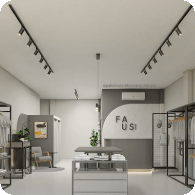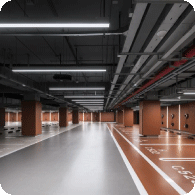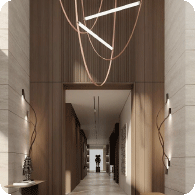
Q: Q: Can I replace my incandescent lights with LEDs?
A: LED technology is very new and still under development. They are currently unavailable for most lighting situations because their quality is not yet of a high enough standard. Beacon Lighting expects that an increasing range of LEDs will become available in six to twelve months and over time the high cost of LEDs will fall. For up-to-date information on the latest LED technologies available speak with the customer service team at Beacon Lighting.
Q: Can low voltage halogen downlights be replaced with CFLs?
A: Low voltage halogen downlights are the most common globe used in Australia today. They are connected directly to transformers and can not be retrofitted with a CFL equivalent. To replace low voltage halogen downlights with CFLs you will require an electrician to remove the transformers and install new lamp holders.
Q: Are low voltage halogen downlights energy efficient?
A: No. Low voltage halogen downlights are also a type of incandescent lamp. Each one generates a kilogram of greenhouse gas every 15 hours which is about the same as a 60 watt incandescent globe.
Q: Does it take more energy to make a CFL than an incandescent bulb?
A: CFLs do require a little more energy to produce however they require 80% less energy to run. Therefore over the life of the globe a CFL uses much less energy than an incandescent lamp.
Q: Is the mercury found in CFLs dangerous?
A: The trace amounts of mercury sealed within glass tubing in CFLs is not dangerous to users when the CFL is in tact or in use because no mercury is released.
However mercury is a toxic substance therefore it’s important that CFLs are handled carefully and disposed of responsibly
Q: Can I Use a Dimmable LED Light Bulb With a Regular (Non Dimmable) Light Switch?
A: LED light bulbs unlike incandescent or halogen have the option to come in both dimmable and non-dimmable versions. This is because when LED light bulbs were first released, it was uncommon for them to be dimmable. As LED bulb internal electronics became more advanced, dimming became possible and ultimately we are at the point today where dimming is essentially a no-cost or low cost adder to most LED bulb types. Because of this, many manufacturers no longer offer a non-dimming option outside vendors who are pursing the lowest retail cost point possible.
Q: If i do not have a dimming switch installed, does installing dimmable LEDs cause any issues?
A: The answer is absolutely not, dimmable LEDs when installed in a non-dimming switch will operate at 100% output and will run just as well as if they were installed with a dimming switch. Sure, there may be a non-dimming option available for a fractionally lower cost but generally speaking, if you plan on keeping your LED bulbs for a long time, it makes sense to choose the dimmable option.
Q: What about installing LED bulbs that are non-dimmable with a dimming switch?
A: If you install a non-dimming LED bulb in a circuit with a dimming switch, it will likely operate normally if the dimmer is at its 100% or fully on. Dimming the bulb, will likely cause erratic behavior such as flickering or buzzing and ultimately may cause damage to the bulb. If you have to do this, we suggest keeping the bulb at full power. Again, as mentioned above, dimmable LED bulbs are overall a better investment.
Q: How Bright is 2700 Kelvin or 5000 Kelvin?
A: Kelvin is not a measure of brightness rather it is a measure of color temperature. If you are looking for brightness, the proper measurement to look for is lumens. In general though, 5000K or cool/daylight white will appear brighter than 2700K all things being equal but this is due to the higher contrast of such light.
Q: How can I calculate how many Lumens to Kelvin?
A: Another common question we get is how do you calculate how many lumens = a certain kelvin. In short, these are two measurements that are not directly related. Kelvin is not a measure of brightness rather it is a measure of color temperature. If you are looking for brightness, the proper measurement to look for is lumens. In general though, 5000K or cool/daylight white will appear brighter than 2700K all things being equal but this is due to the higher contrast of such light.
Q: How much heat is generated by LED light bulbs?
A: Contrary to some marketing claims, LED bulbs do indeed generate heat as does anything that consumes electricity. but LEDs consume a lot less energy than incandescent or halogen bulbs and are much more efficient in how they use that energy versus traditional bulb types.
LED bulbs have many components inside to change the high voltage electricity from your home or building to the lower voltage that the LED chips need to run. Because of this, they are much more sensitive to heat than incandescent or halogen sources. You will frequently find that many low cost LED bulbs carry a warning that they should not be placed in fully enclosed fixtures. The reason for this is that this heat build up can shorten the life of the components inside of the LED bulb. Only use fully enclosed rated LED bulbs in fixtures of this type or you may void the warranty.
Q: Does a Higher Color Temperature (Kelvin) Bulb Produce More Light?
A: When shopping for LED bulbs, the color temperature of the light, rated in Kelvin, is a frequently cited specification. Shoppers are often confused if buying a higher Kelvin bulb will produce more light. Lumens are a measurement of total light output while Kelvin describes the color of the light. LED bulbs of a higher Kelvin may appear brighter due to the higher contrast the cooler light provides but often are equal or just slightly brighter on a Lumens measurement.
Q: Is there an easy way to download cut/spec sheets?
A: Cut/spec sheets for products are available for download in each product's description.
Q: Who can I contact if I still need help or have more questions?
A: We are happy to help you if you still have questions or require additional help. You can reach out to us by:
Contacting Arrco Sales Rep
Call us at 971 4 2666450
Email us at: [email protected]
Or by simply filling up the form in our contact us section and we will surely get back to you at our earliest.



















